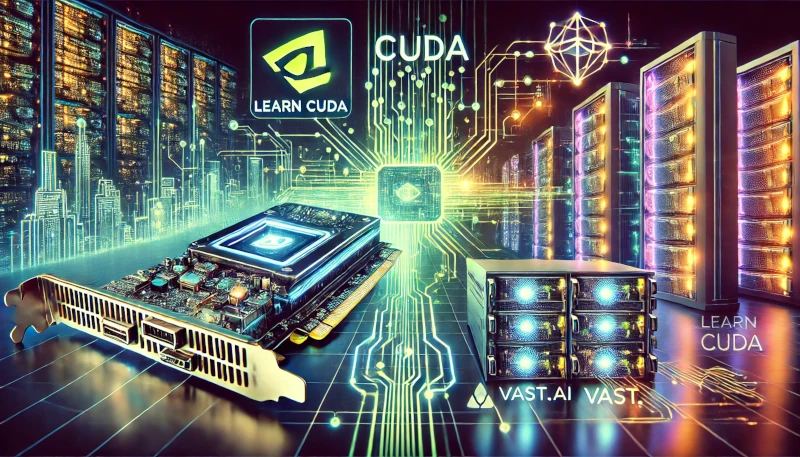Choosing a GPU Cloud Provider for Learning CUDA
In this post we compare the different GPU cloud providers and try to find the best ones for those who want to learn CUDA.

Choosing the Right GPU Server Provider for Learning CUDA Programming
Learning CUDA programming is an awesome ride into the world of parallel computing and high-performance processing. We’re in the middle of a major shift in how we see computing, with massively parallel processors taking center stage and changing the game.
Programming these massively parallel processors is still challenging, and not many people have mastered the art of writing efficient CUDA code. By stepping up and mastering CUDA now, you can tap into huge performance gains (in terms of invested dollars), build faster applications, and position yourself as an expert in this important area, opening up opportunities in fields from AI to real-time graphics and beyond.
But before you start crafting your kernels and running benchmarks, you need the right GPU server provider.
In this post, we’ll explore how to choose the perfect provider for learning CUDA, experiment with diverse hardware, and avoid those dreaded surprise bills. Spoiler: if you’re a learner, on-demand providers like TensorDock, Vast.ai, RunPod.io and Genesis Cloud are hard to beat.
1. Experimenting with Different Hardware: Consumer vs. Server-Grade
When you’re just starting out with CUDA, the ability to try out different hardware setups is invaluable.
Consumer GPUs
These GPUs, commonly found in gaming rigs and high-end desktops, are affordable and powerful enough for learning and benchmarking. They might not have the enterprise features—such as ECC memory or specialized drivers—but they’re perfect for hands-on experimentation and understanding CUDA fundamentals.
Server-Grade GPUs
Built for reliability and sustained workloads, server-grade GPUs come with features like error-correcting memory and specialized drivers. They’re essential for production-level tasks and large-scale machine learning training but can be overkill (and significantly more expensive) for someone focused on learning CUDA.
The Bottom Line
For learners, the flexibility to run code on both consumer and server-grade GPUs provides a richer understanding of CUDA’s performance nuances without burning a hole in your wallet.
2. Cloud Provider Dynamics: Big vs. Small
The cloud landscape is split between big providers and smaller, specialized services. Here’s where your priorities come into play:
Big Cloud Providers (e.g., AWS EC2, Google Cloud)
These giants offer robust, reliable infrastructure with extensive support. However, they typically run on a pay-as-you-go model that can lead to surprise bills if you forget to shut down your instances. While they deliver high-end, server-grade GPUs, the pricing model isn’t very forgiving for learners who are experimenting or running short benchmarks.
Small Providers (e.g., TensorDock, Vast.ai, RunPod.io, Genesis Cloud)
Smaller providers tend to offer on-demand, upfront payment models that help you avoid unexpected charges. They often give you access to a diverse range of GPUs—including affordable consumer-grade models—making them ideal for learning and benchmarking. Yes, there can be occasional availability issues during peak times, but when you’re learning, that trade-off is usually worth it.
Our Take
For anyone learning CUDA, the freedom and cost control offered by on-demand, smaller providers are a clear win over the inflexible billing models of big cloud providers.
3. Contract vs. On-Demand: Your Choice
Understanding the pricing models is critical when choosing a provider:
On-Demand Instances
These allow you to pay only for what you use, giving you the freedom to experiment without long-term commitments. On-demand models let you switch between different hardware types as needed, which is perfect for learning and benchmarking. Providers like TensorDock and Vast.ai are built around this model, offering flexibility and affordability.
Contracts and Reserved Instances
These options require a long-term commitment—often a year or more—and are designed for enterprise-level workloads such as extensive machine learning training. While these contracts usually offer discounted pricing and guaranteed uptime, they’re not well-suited for learners who need flexibility and minimal risk of overpaying.
Our Verdict
If your goal is to learn and experiment with CUDA, on-demand services are the way to go. The flexibility and cost predictability outweigh the minor inconvenience of occasional availability hiccups.
Provider Comparison Table
Below is a handy table that breaks down providers by their focus, so you can quickly see which ones are best for learning CUDA versus production ML training:
| Category | Providers |
|---|---|
| On-Demand (Ideal for Learning CUDA) | TensorDock – Affordable, upfront payments with a diverse range of GPUs and fast deployment. Vast.ai – Flexible real-time bidding system with competitive rates and broad GPU selection. RunPod.io – On-demand instances with support for spot pricing and persistent storage. Genesis Cloud – Cost-effective and user-friendly for high-performance GPU access. |
| Contracted/Reserved (Best for ML Training) | Lambda Labs – Offers both on-demand and reserved instances, with long-term contracts ensuring guaranteed performance. CoreWeave – Enterprise-grade GPU infrastructure with reserved contracts for consistent uptime. |
| Big Cloud Providers (Enterprise-Grade) | AWS EC2 – Extensive services with reserved instances available for long-term workloads. Google Cloud – Global infrastructure with committed use discounts for guaranteed resource availability. |
Conclusion
When it comes to learning CUDA programming, flexibility and cost control are your best friends. On-demand providers empower you to experiment freely with a variety of GPUs—be it consumer or server-grade—without the burden of long-term contracts or surprise bills.
While big cloud providers and reserved contracts have their place in heavy-duty ML training, for a curious learner eager to explore CUDA, the on-demand model offers unmatched versatility and affordability.
Happy massively-parallel-processor programming!
